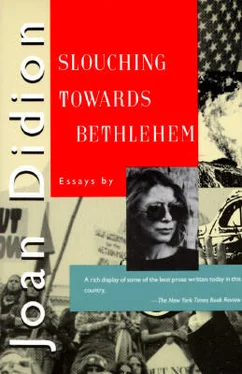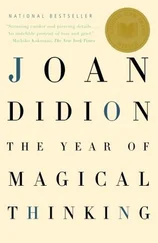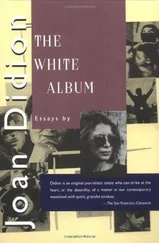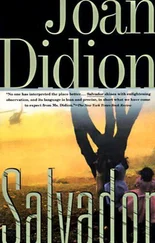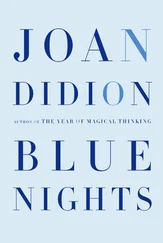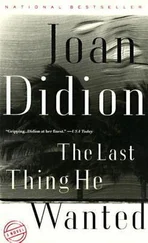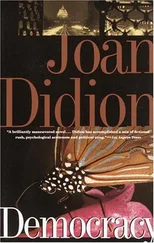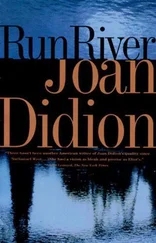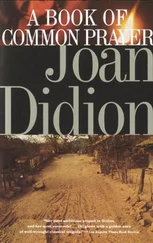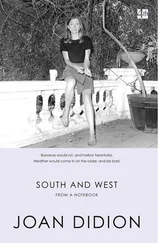Here is where the hot wind blows and the old ways do not seem relevant, where the divorce rate is double the national average and where one person in every thirty-eight lives in a trailer. Here is the last stop for all those who come from somewhere else, for all those who drifted away from the cold and the past and the old ways. Here is where they are trying to find a new life style, trying to find it in the only places they know to look: the movies and the newspapers. The case of Lucille Marie Maxwell Miller is a tabloid monument to that new life style.
Imagine Banyan Street first, because Banyan is where it happened. The way to Banyan is to drive west from San Bernardino out Foothill Boulevard, Route 66: past the Santa Fe switching yards, the Forty Winks Motel. Past the motel that is nineteen stucco tepees: “sleep in a wigwam — get more for your wampum.” Past Fontana Drag City and the Fontana Church of the Nazarene and the Pit Stop A Go-Go; past Kaiser Steel, through Cucamonga, out to the Kapu Kai Restaurant-Bar and Coffee Shop, at the corner of Route 66 and Carnelian Avenue. Up Carnelian Avenue from the Kapu Kai, which means “Forbidden Seas,” the subdivision flags whip in the harsh wind.
“HALF-ACRE RANCHES! SNACK BARS! TRAVERTINE ENTRIES! $95 down.” It is the trail of an intention gone haywire, the flotsam of the New California. But after a while the signs thin out on Carnelian Avenue, and the houses are no longer the bright pastels of the Springtime Home owners but the faded bungalows of the people who grow a few grapes and keep a few chickens out here, and then the hill gets steeper and the road climbs and even the bungalows are few, and here — desolate, roughly surfaced, lined with eucalyptus and lemon groves — is Banyan Street.
Like so much of this country, Banyan suggests something curious and unnatural. The lemon groves are sunken, down a three- or four-foot retaining wall, so that one looks directly into their dense foliage, too lush, unsettlingly glossy, the greenery of nightmare; the fallen eucalyptus bark is too dusty, a place for snakes to breed. The stones look not like natural stones but like the rubble of some unmentioned upheaval. There are smudge pots, and a closed cistern. To one side of Banyan there is the flat valley, and to the other the San Bernardino Mountains, a dark mass looming too high, too fast, nine, ten, eleven thousand feet, right there above the lemon groves. At midnight on Banyan Street there is no light at all, and no sound except the wind in the eucalyptus and a muffled barking of dogs. There may be a kennel somewhere, or the dogs may be coyotes.
Banyan Street was the route Lucille Miller took home from the twenty-four-hour Mayfair Market on the night of October 7, 1964, a night when the moon was dark and the wind was blowing and she was out of milk, and Banyan Street was where, at about 12:30 a. m., her 1964Volkswagen came to a sudden stop, caught fire, and began to burn. For an hour and fifteen minutes Lucille Miller ran up and down Banyan calling for help, but no cars passed and no help came. At three o’clock that morning, when the fire had been put out and the California Highway Patrol officers were completing their report, Lucille Miller was still sobbing and incoherent, for her husband had been asleep in the Volkswagen. “What will I tell the children, when there’s nothing left, nothing left in the casket,” she cried to the friend called to comfort her. “How can I tell them there’s nothing left?”
In fact there was something left, and a week later it lay in the Draper Mortuary Chapel in a closed bronze coffin blanketed with pink carnations. Some 200 mourners heard Elder Robert E. Denton of the Seventh-Day Adventist Church of Ontario speak of “the temper of fury that has broken out among us.” For Gordon Miller, he said, there would be “no more death, no more heartaches, no more misunderstandings.” Elder Ansel Bristol mentioned the “peculiar” grief of the hour. Elder Fred Jensen asked “what shall it profit a man, if he shall gain the whole world, and lose his own soul?” A light rain fell, a blessing in a dry season, and a female vocalist sang “Safe in the Arms of Jesus.” A tape recording of the service was made for the widow, who was being held without bail in the San Bernardino County Jail on a charge of first-degree murder.
Of course she came from somewhere else, came off the prairie in search of something she had seen in a movie or heard on the radio, for this is a Southern California story. She was born on January 17, 1930, in Winnipeg, Manitoba, the only child of Gordon and Lily Maxwell, both schoolteachers and both dedicated to the Seventh-Day Adventist Church, whose members observe the Sabbath on Saturday, believe in an apocalyptic Second Coming, have a strong missionary tendency, and, if they are strict, do not smoke, drink, eat meat, use makeup, or wear jewelry, including wedding rings. By the time Lucille Maxwell enrolled at Walla Walla College in College Place, Washington, the Adventist school where her parents then taught, she was an eighteen-year-old possessed of unremarkable good looks and remarkable high spirits. “Lucille wanted to see the world,” her father would say in retrospect, “and I guess she found out.”
The high spirits did not seem to lend themselves to an extended course of study at Walla Walla College, and in the spring of 1949 Lucille Maxwell met and married Gordon (“Cork”) Miller, a twenty-four-old graduate of Walla Walla and of the University of Oregon dental school, then stationed at Fort Lewis as a medical officer. “Maybe you could say it was love at first sight,” Mr. Maxwell recalls. “Before they were ever formally introduced, he sent Lucille a dozen and a half roses with a card that said even if she didn’t come out on a date with him, he hoped she’d find the roses pretty anyway.” The Maxwells remember their daughter as a “radiant” bride.
Unhappy marriages so resemble one another that we do not need to know too much about the course of this one. There may or may not have been trouble on Guam, where Cork and Lucille Miller lived while he finished his Army duty. There may or may not have been problems in the small Oregon town where he first set up private practice. There appears to have been some disappointment about their move to California: Cork Miller had told friends that he wanted to become a doctor, that he was unhappy as a dentist and planned to enter the Seventh-Day Adventist College of Medical Evangelists at Loma Linda, a few miles south of San Bernardino. Instead he bought a dental practice in the west end of San Bernardino County, and the family settled there, in a modest house on the kind of street where there are always tricycles and revolving credit and dreams about bigger houses, better streets. That was 1957. By the summer of 1964 they had achieved the bigger house on the better street and the familiar accouterments of a family on its way up: the $30, 000 a year, the three children for the Christmas card, the picture window, the family room, the newspaper photographs that showed “Mrs. Gordon Miller, Ontario Heart Fund Chairman….“They were paying the familiar price for it. And they had reached the familiar season of divorce.
It might have been anyone’s bad summer, anyone’s siege of heat and nerves and migraine and money worries, but this one began particularly early and particularly badly. On April 24 an old friend, Elaine Hayton, died suddenly; Lucille Miller had seen her only the night before. During the month of May, Cork Miller was hospitalized briefly with a bleeding ulcer, and his usual reserve deepened into depression. He told his accountant that he was ‘‘sick of looking at open mouths,” and threatened suicide. By July 8, the conventional tensions of love and money had reached the conventional impasse in the new house on the acre lot at 8488 Bella Vista, and Lucille Miller filed for divorce. Within a month, however, the Millers seemed reconciled. They saw a marriage counselor. They talked about a fourth child. It seemed that the marriage had reached the traditional truce, the point at which so many resign themselves to cutting both their losses and their hopes.
Читать дальше
